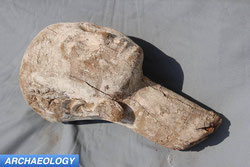
Archaeologists from the Universities of Cambridge and Surrey have conducted ancient DNA analyses on a medieval skull found in a garden in Suffolk, England, and their results will have you rethinking the cute little squirrel family in your front yard.
According to the research team, the skull is from a middle aged woman who lived sometime between 885 and 1015 CE. She lived in East Anglia, a region in the east of England that consists of Norfolk, Suffolk, Cambridgeshire, and Essex. East Anglia was a leprosy hotspot in medieval times, and, based on cranial deformations and ancient DNA results, the woman was one of its many victims.
Given the prevalence of leprosy at the time, it isn’t too surprising the woman had the disease. What makes her case interesting, however, is the strain of leprosy from which she suffered. Genetic testing shows it’s the same strain that infects modern day squirrels living in southeast England.
But what’s the connection between the woman and the squirrels? According to the research team, there was an active medieval trade network that trafficked in squirrel meat and pelts. Vikings from Scandinavia brought the “highly prized” squirrels to East Anglia, and the archaeologists believe leprosy infected squirrels may have transmitted the disease to humans.
In a statement, lead researcher Sarah Inskip said,
"Research has already established that leprosy can be passed from armadillos to humans, so that it may also come from squirrels is an interesting idea. It is questionable how long the bacteria could have survived on fur or meat, but it's notable that squirrels were also sometimes kept as pets."
The team points out the seeming prevalence of leprosy in East Anglia could be due to better preservation of medieval bodies in the area, but they think that’s unlikely. Or as Inskip says, "Perhaps it's the movement of people and prolonged connection between East Anglia and Scandinavia that's important to our understanding of the history of leprosy in the UK, but further research refuting or confirming the role of the fur trade could be highly enlightening and exciting.”
The group published their work in the Journal of Medical Microbiology.



